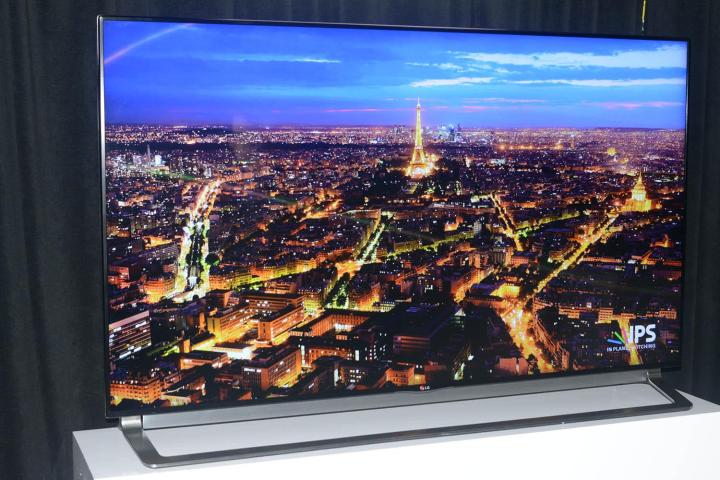
Check out our review of the LG 65LA9700 4K UHDTV.
LG is building something of a tradition by showing up at CEDIA without actually showing up at CEDIA. In other words, it recognizes a bunch of press are all in one place at the same time, and uses the opportunity to provide a nice, quiet, offsite venue where everyone in attendance can get an intimate look at LG’s latest and greatest products. In this case, that included all of the new additions to the company’s 4K Ultra HDTV lineup.
Today, Digital Trends did not get a look at LG’s super-hot 77-inch Ultra HD OLED TV, but we did get up close and personal with the company’s 55-inch ($4500) and 65-inch ($6500) LA9700 4K Ultra HDTV’s and its less expensive 55-inch ($3500) and 65-inch ($5000) LA9650 models.
The LA9700’s are essentially smaller siblings to LG’s massive 84-inch LM9600 Ultra HD set, which sells for $17,000. That means a difference of less than 20-inches amounts to price gap of more than $10,000 in Ultra HD sets right now. And that makes the mammoth 84-incher a tougher sell, because the $6500, 65-inch versions sports some excellent, 144-zone, full-array local dimming, which provides for superior black levels and, therefore, overall picture quality. While the smaller 55-inch model in the series doesn’t boast as many local dimming zones, it still does a great job. Both models also come with a pretty slick motorized speaker system that hides out of view when the set is turned off.
But then we have the dare we say … affordable? … $3500 and $5000 versions, which bring Ultra HD down to earth for a pretty large section of consumers. And, with CES right around the corner, it’s safe to say we’ll see newer models coming in 6 months with even lower prices.
So, it would seem the next generation in television is getting more affordable by the minute (ok … by the month). But does 4K at 65-and 55-inch sizes make any sense? LG thinks so. The company spent a fair amount of time extolling the virtues of its television’s upscaling capabilities, which can take 1080p content and bump it up to 4K resolution. We haven’t had enough time to thoroughly evaluate the quality of this upscaling, but what we can say is that 4K looks better than upscaled 1080p, even at these smaller sizes.

But what about the future of 4K? Are these early sets future-proofed enough to consider buying? LG says yes to that, too. While the company has no specific upgrade plan to bring the sets into compliance with the recently released HDMI 2.0 standard, it assured us that such a solution is on the way. And, hey, if Sony can bring its 4K sets into the future with a simple firmware update, one would hope that LG could develop a similar plan. Time will tell.
At the end of it all, we walked away with one very clear impression: Ultra HD is not a flash-in-the-pan, doomed-to-die-an-ugly-death technology in the same way we think 3D is. So, if you’re not ready to plop down $3500 – $6500 on a 4K TV just yet, don’t worry. The right moment is coming right around the corner. And way sooner than OLED.
Editors' Recommendations
- LG’s fantastic C3 OLED 4K TV is up to $1,300 off right now
- What we want to see from the next Apple TV 4K
- Sony debuts the Bravia 9, its brightest 4K TV ever, alongside new 2024 models
- Samsung’s new 98-inch DU9000 4K TV is just $4,000. Can it beat TCL and Hisense?
- This 75-inch 4K TV is discounted from $650 to $490 right now







